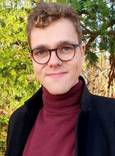Hauptinhalt
Topinformationen
Philip Sulewski

Room t.b.a
Institute of Cognitive Science,
Wachsbleiche 27,
49090 Osnabrück, Germany
Supervisors
Prof. Dr. Tim C. Kietzmann
Prof. Dr. Peter König
External collaboration
Dr. Martin Hebart (Vision and Computational Cognition Group - MPI CBS)
Towards a better understanding of visual information sampling in the brain: neural correlates and deep neural network models of the exploration-exploitation dilemma
Research interests
My research focuses on the neural mechanisms underlying the extraction and integration of visual information within and across multiple fixations. I am interested in how we dynamically sample and procecces visual information and how that enables us to iteratively build a rich understanding of our visual environment that goes beyond the detection of object categories.
Current project
Instead of perceiving the visual world all at once, we explore it gradually through fixational eye movements (saccades). These are necessary because only the fovea of our eye, a small part of the retina, provides high spatial resolution. Only when we fixate a location of interest, we are able to perceive it with high accuracy. However, moving our eyes, implies a new sensory input to the visual system, which disrupts the ongoing information processing. Therefore, during the short time span of a fixation, our brain has to decide not only where to look next, but more importantly, how long to fixate on a particular location. In short, the brain faces a constant exploration-exploitation dilemma in which it must decide whether to continue analyzing a particular location (exploitation) or to seek further external information at the cost of disrupting ongoing processing (exploration). To gain insight into the neural representational dynamics underlying visual information sampling, we record neural activity using magnetoencephalography (MEG) combined with eye tracking while subjects visually explore natural scenes. This setup allows us to investigate which aspects of the continuously changing neural signatures are predictive for human fixation durations. The insights gained here will be valuable for the study of human vision and neuroscientific principles of information processing in general. However, they also hold promise for successful translation to other fields and practical applications, particularly in the area of artificial intelligence (AI). Many applications in AI, especially in computer vision, face the same information processing dilemma as the visual system: where, when, and for how long to invest limited computational resources.
Topinformationen
Conference contribution
Sulewski, P., König, P., Kriegeskorte, N., & Kietzmann, T.C. (2021). Analyses of the neural population dynamics during human object vision reveal two types of representational echoes that reverberate across the visual system. Neuromatch 4.0 Video


